Improving resilience with fiber-cement siding
by sadia_badhon | March 13, 2019 10:20 am
by David Hohenstern
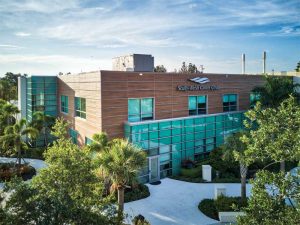 [1]
[1]Fiber cement can increase the resilience of homes and other structures in the face of environmental threats posed by the sun, precipitation, wind, and fire. In order to maximize the performance of fiber cement against the elements and to successfully install them, owners and builders must be aware of clearances, flashing, placement of joints, proper installation tools, and other requirements provided by manufacturers.
Physical properties of fiber cement
Fiber cement consists of fibrous materials such as wood pulp mixed with Portland cement, water, and silica or fly ash. By virtue of its physical properties, fiber-cement siding is less susceptible to common environmental threats compared to traditional wood cladding. For example, in coastal regions, natural wood is vulnerable to airborne salt water that may accelerate deterioration. Elsewhere, wood siding may be compromised with rot caused by common fungi. Given that fiber cement is at least 70 percent inorganic, neither of these environmental features can significantly impact its longevity or appearance.
This increased durability does not require any aesthetic sacrifices. Available as boards and architectural wall panels, fiber cement is versatile and can be processed and pressed to create products of varying sizes, lengths, thicknesses, and textures. It can also be molded to closely resemble natural products, such as wood and stone, or fashioned to foster a clean, ultra-modern look.
Unlike vinyl, both wood and fiber cement can be painted. To keep its appearance, wood siding needs to be repainted every three to five years. According to the Portland Cement Association (PCA), fiber cement siding can retain its painted appearance for 15 years.
Sun and heat
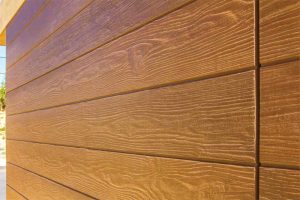 [2]
[2]In California, heat and thermal expansion pose regular threats to the longevity of cladding materials. Inland, it is common to experience 30 consecutive days of dry, hot conditions—temperatures can often reach 38 C (100 F) or higher. In other areas, such as in the Central Valley, the temperatures swing from hot during the day to cold at night.
Fiber-cement siding resists the impact of thermal expansion. This is relevant to areas experiencing significant heat and temperature fluctuations, as heat increases the movement of matter’s constituent atoms and molecules, meaning, as the particles move, they occupy more space, resulting in expansion of the material. Cold temperatures have an opposite effect, causing matter to contract. The rate at which different substances expand and contract varies based on the strength of the forces bonding the atoms. Fiber cement has stronger bonds[3] than wood, making it a more stable material and resistant to expansion and contraction in conditions where wood siding might crack or chip.
Precipitation and moisture
Real wood is a hygroscopic material, meaning it expands as it absorbs moisture and contracts as the wood dries. Therefore, humidity is another environmental element impacting fiber cement to a lesser degree than wood.
Manufacturers use ASTM E331, Standard Test Method for Water Penetration of Exterior Windows, Skylights, Doors, and Curtain Walls by Uniform Static Air Pressure Difference, and the American Architectural Manufacturers Association (AAMA) 509, Voluntary Test and Classification Method for Drained and Back Ventilated Rain Screen Wall Cladding Systems, tests to prove that properly installed fiber-cement sidings have the abilty to resist water.
Compared to vinyl and wood siding, modern fiber cement is impact-resistant. Falling hail, snow, ice, and even harsh torrential rain have minimal effects, and the panels can successfully resist water penetration. The previously mentioned tests simulate rain driven by 121 km/h (75 mph) winds, and pressures of 575 to 766 Pa (12 to 16 psf). A properly installed fiber cement system should allow minimal moisture to reach the weather barriers.
Some assemblies are equipped with an additional gasket to prevent infiltration of water and air at the top and sides. With shiplap edges, panels fit together so joints are concealed, and all the four edges effectively form a gasket on their own. Manufacturers take additional precautions by including the drainage channels between the sheathing and back face of the panels. These channels ensure water penetrating the system drains out quickly.
Building owners can take additional precautions, such as properly maintaining weather barriers as a backup for moisture-draining systems and installing kick-out flashings to divert rain away from wall faces, maintain clearances, and keep landscaping clear.
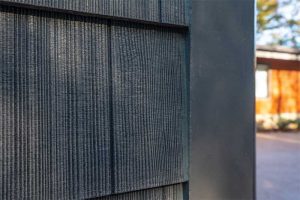 [4]
[4]In cases of snow accumulation, the thickness and flexural strength of fiber cement allows it to withstand the physical force exerted by the snow that piles up against a structure. Residential-grade fiber cement is made using a wet process for mixing water with the fibrous material, silica, and Portland cement. This means residential-grade products have some sensitivity to thaw and pre-thaw in cold climates. For this reason, fiber cement made without water might be more appropriate for northern Midwest states as it is less vulnerable to cold conditions.
Wind
As high-velocity hurricane zones (HVHZ), Florida’s Miami-Dade and Broward counties have established strict building codes to ensure structures can resist potentially severe wind loads. Architects across the country look to these counties when specifying for structures that must be resilient to storms.
Some manufacturers offer commercial-grade fiber cement panel systems, able to withstand pressures of up to 4549 Pa (95 psf), for use in HVHZs. Miami-Dade maintains a checklist for fiber cement products approved for use, including detailed product and installation information along with test results and reports. The Florida Building Code (FBC) requires approved products to pass the following tests in compliance with the Testing Application Standard (TAS) 301, Testing Laboratory:
- ASTM C1185, Standard Test Methods for Sampling and Testing Non-Asbestos Fiber-Cement Flat Sheet, Roofing and Siding Shingles, and Clapboards;
- ASTM E84, Standard Test Method for Surface Burning Characteristics of Building Materials;
- ASTM E136, Standard Test Method for Behavior of Materials in a Vertical Tube Furnace at 750 C;
- TAS 202, Criteria for Testing Impact and Nonimpact Resistant Building Envelope Components Using Uniform Static Air Pressure;
- TAS 201, Impact Test Procedures;
- TAS 203, Criteria for Testing Products Subject to Cyclic Wind Pressure Loading; and
- TAS 100, Test Procedure for Wind and Wind Driven rain Resistance of Discontinuous Roof Systems.
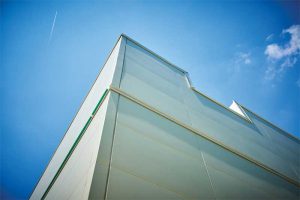 [5]
[5]Fiber-cement siding installed in front of concrete block construction satisfying ASTM C90, Standard Specification for Loadbearing Concrete Masonry Units, for loadbearing concrete does not require impact and positive pressure tests for HVHZ approval. The same is true for fiber cement installed in front of 16-mm (5/8-in.) plywood supported by 406-mm (16-in.) on center (o.c.) 2x wood or metal framing. Still, some fiber cement manufacturers have conducted impact testing to measure how their products would perform in a hurricane. Tests might include blasting a 2×4 from a 90-degree angle perpendicular to it at 145 km/h (90 mph) to determine weak or unsupported points.
Fiber cement’s capacity for wind resistance varies by product and installation. Commercial-grade panels are engineered to withstand high wind loads, along with an option to install with high-performance hardware. To meet the challenge of unusually high wind loads, commercial panel framing can be upgraded from 18 to 16-gauge metal to strengthen the hold of the panel’s fasteners or use steel hardware instead of aluminum for added strength.
Fire
In encounters with fire, wood siding quickly becomes fuel and vinyl melts. Fiber-cement siding—consisting of mostly nonflammable cement and silica—resists combustion. Organizations such as ASTM, the National Fire Protection Association (NFPA), and the Underwriters Laboratories of Canada (ULC) have developed an array of tests for utilization by manufacturers and governments to measure the ignition resistance, combustibility, and flame spread in building/wall products. Tests include:
- ASTM E84;
- ULC S102-10, Standard Method of Test for Surface Burning Characteristics of building Materials and Assemblies;
- ULC S134-13, Standard Method of Fire Test of Exterior Wall Assemblies;
- NFPA 268, Standard Test Method for Determining Ignitability of Exterior Wall Assemblies Using a Radiant Heat Energy Source; and
- NFPA 285, Standard Fire Test Method for Evaluation of Fire Propagation Characteristics of Exterior Non-Load-Bearing Wall Assemblies Containing Combustible Components.
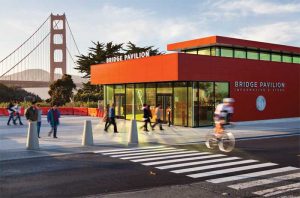 [6]
[6]These tests allow manufacturers to prove fiber cement may be safely used with wall assemblies that organizations have rated as fire-resistant. Manufacturers have also demonstrated which fiber cement products have a flame spread index (FSI) of zero and qualify as Class A building materials under ASTM E84.
Fiber cement’s proven capacity for resisting fire is particularly relevant to the people who live and work in California, Colorado, Idaho, Ohio, Montana, Nevada, Wyoming, and other areas at high-risk for wildfires. In chapter 7 of the state’s building code, California (a trendsetter when it comes to codes and construction) established standards and guidelines for materials and construction methods to help increase a building’s fire resilience and the survivability of people and property located in areas designated as fire hazard severity zones or wildland-urban interface (WUI) fire areas. Fiber cement products have been tested and proven for use in WUI areas and can help protect buildings from ignition by embers that can fly as far as a mile away from a wildfire.
California’s Office of the State Fire Marshal (SFM) manages the Building Materials Listing (BML) Program that lists tested and approved products (including fiber cement) in compliance with Chapter 7A of the California Building Code (CBC). To be listed in BML, all products must be tested and labeled by an SFM-accredited laboratory. Fiber cement is assessed under testing standard CA SFM 12.7A-1, Exterior Wall Siding and Sheathing.
While using tools like California’s BML to choose compliant products will increase overall fire resistance, fiber cement could not make a home or business completely invulnerable to fire. Fiber cement provides another layer of protection for people and property. To achieve optimal results in terms of fire resistance, it is best to follow best practices such as keeping at least 152 mm (6 in.) of clearance between siding and combustible items such as plants or mulch.
Case in point
In October 2017, a series of 250 destructive wildfires spread across northern California. The Tubbs Fire alone resulted in the deaths of 22 people and the destruction of more than 5643 buildings across Lake, Napa, and Sonoma counties. Another fire, the Redwood Valley Mendocino Lake Complex Fire, burned 14,780 ha (36,523 acres) before it was contained.
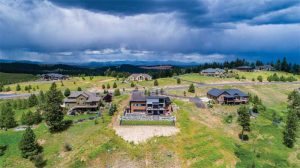 [7]
[7]In Redwood Valley, California, one homeowner watched as the latter incinerated every house in his neighborhood, including his own place. No structure was left standing except for a standalone home office on his property that endured in part because of the resilience enabled by its fiber cement cladding.
The homeowner built his 130-m2 (1400-sf) standalone home office roughly 10 years ago. With ample room on the 2-ha (5-acre) property, the office stood 53 m (175 ft) away from a 186-m2 (2000-sf) home built 16 years ago. Flanked by vineyards to the west and north, the primary home was custom-built with a marble entryway, solid fir doors, hardwood floors, and redwood siding, among other high-end details. The property also included a 279-m2 (3000 sf) deck made of redwood.
The family opted to use fiber-cement siding for the home office because it would match the look of their redwood home but require significantly less maintenance. Prefinished siding with machine-applied coating is engineered to provide long-lasting color, enhanced durability, and a consistent appearance.
When the fires approached, the homeowner tried to save his home, but wind gusts of 80 to 96.5 km/h (50 to 60 mph) were spreading the flames too rapidly to be combatted. The fire consumed the custom-built home within 15 minutes, and for the next three hours, the home office was battered with embers and wind gusts reaching upwards of 96.5 km/h. Despite the extreme conditions, the fiber-cement siding and the home office remained intact and largely unaffected. The family lost their primary home in the historic wildfire, but they have continued to live on their property by relocating into the home office.
Fiber cement is not magic, but when applied per manufacturer-recommended installation instructions and best practices, it maintains its attractiveness in the face of environmental threats and enables homeowners and businesses to better protect structures and people. As another layer of protection from sun exposure, humidity, snowfall, and even wildfires, fiber cement improves resilience while retaining the versatility to satisfy a wide range of aesthetic preferences.
David Hohenstern is a technical manager at Nichiha USA. Based in John’s Creek, Georgia, Hohenstern leads the team providing customer and sales support, project reviews, the creation and management of technical documents, research and development, product testing, and building code compliance-related functions for Nichiha’s product lines. He holds a master of science degree in building construction and facility management from Georgia Tech. Hohenstern can be reached at dhohenstern@nichiha.com[8].
- [Image]: https://www.constructionspecifier.com/wp-content/uploads/2019/03/001_nichiha_scully-welsh_verobeach_by_brianadamsphoto.com_.jpg
- [Image]: https://www.constructionspecifier.com/wp-content/uploads/2019/03/Nichiha-Fiber-Cement-Image-2.jpg
- Fiber cement has stronger bonds: http://waldmaneng.com/is-fiber-cement-siding-right-for-you
- [Image]: https://www.constructionspecifier.com/wp-content/uploads/2019/03/Nichiha-Fiber-Cement-Image-1.jpg
- [Image]: https://www.constructionspecifier.com/wp-content/uploads/2019/03/Nichiha-Fiber-Cement-Image-7.jpg
- [Image]: https://www.constructionspecifier.com/wp-content/uploads/2019/03/Nichiha-Fiber-Cement-Image-6.jpg
- [Image]: https://www.constructionspecifier.com/wp-content/uploads/2019/03/Nichiha-Fiber-Cement-Image-5.jpg
- dhohenstern@nichiha.com: mailto:dhohenstern@nichiha.com
Source URL: https://www.constructionspecifier.com/improving-resilience-with-fiber-cement-siding/